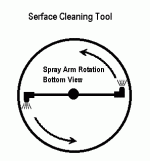You are using an out of date browser. It may not display this or other websites correctly.
You should upgrade or use an alternative browser.
You should upgrade or use an alternative browser.
Surface cleaner nozzle direction
- Thread starter beyoungsr
- Start date
Steven Rowlett
Member
Also make sure the are at the correct angle. Your machine should have come with a guage.
Steven Rowlett
Member
Take a piece of sturdy plastic such ad Lexan about 4" wide and 5" tall, lay a protractor on the 4" edge and make a mark on the 91 degree mark to the left side and cut at that angle. This will give you the correct angle when the gauge is resting on the surface cleaner. The tips should also be the same height on both bars. The distance is 3 1/2" for a Steel Eagle, check yours and make gauge acordingly to your machine. This should be checked often because picking up a rock can bend an arm and knock it out of alignment.
Steven Rowlett
Member
You can use a vise.
Mark
New member
That is some great info on nozzle alignment etc. 
If you have a "Steel Eagle" you should have received a gauge with
your unit, I can get you one if you like.
Realigning arms using a gauge to check alignment is great, be careful
in attempting to straighten "Bent Spray Bars" if you run one with even
a Very Slight bend in it, you could damage the bearings in your swivel.
Most manufacturers suggest replacing damaged spray bars, as it is very
difficult to straighten them perfectly, and even the slightest bend can set
up a high speed wobble damaging the swivel.
If you have a "Steel Eagle" you should have received a gauge with
your unit, I can get you one if you like.
Realigning arms using a gauge to check alignment is great, be careful
in attempting to straighten "Bent Spray Bars" if you run one with even
a Very Slight bend in it, you could damage the bearings in your swivel.
Most manufacturers suggest replacing damaged spray bars, as it is very
difficult to straighten them perfectly, and even the slightest bend can set
up a high speed wobble damaging the swivel.
Hotwaterwizard
Hotsy Service Tech
Make sure the nozzles are parallel with the arms and the elbow angle always points to the left when looking at it from the bottom. This makes it spinn counterclockwize from the top and clockwize from the bottom view.
Hotwaterwizard
Hotsy Service Tech
Hotwaterwizard
Hotsy Service Tech
In my opinion (based on my design engineering experience) anything between 10 and 25 degrees off vertical will work.
As you go closer to vertical, cleaning pressure increases, thrust load on the rotary joint bearings increase and speeds are reduced. As you go closer to 25 degrees, your cleaning pressures are reduced, the thrust load on the bearings are reduced and it's easier to get higher RPM's. After about 25-30 degrees everything diminishes drastically.
If you have radial bearings, they will fail faster as thrust loads increase (also the faster the RPM the sooner it will fail). With angular contact bearings, your thrust loads can go pretty high along with RPM.
Looks like a big difference between the Steel and HydroTwister set-up (7-1/2 to 22 degrees respectively). If you're going to ERR with the Steel Eagle set-up, do it towards 10 degrees rather than the other way. (Even with a gauge you're not going to set an exact angle.) I could tell you a lot more if I knew what brand, type and class bearings were in each one (if anyone cares).
Another item that was mentioned that I agree to be very critical for the rotary joint is keeping the arms straight as this will wear out the union very fast (you can usually feel it - it will wobble and shake more than normal when running).
Good info folks - "Surface Cleaner Engineering 102"
Does anyone know what brand rotary unions are in either of these units? I'd be curious to know. The brochures don't seem to give you the information on the most critical part of the system.
Regards,
As you go closer to vertical, cleaning pressure increases, thrust load on the rotary joint bearings increase and speeds are reduced. As you go closer to 25 degrees, your cleaning pressures are reduced, the thrust load on the bearings are reduced and it's easier to get higher RPM's. After about 25-30 degrees everything diminishes drastically.
If you have radial bearings, they will fail faster as thrust loads increase (also the faster the RPM the sooner it will fail). With angular contact bearings, your thrust loads can go pretty high along with RPM.
Looks like a big difference between the Steel and HydroTwister set-up (7-1/2 to 22 degrees respectively). If you're going to ERR with the Steel Eagle set-up, do it towards 10 degrees rather than the other way. (Even with a gauge you're not going to set an exact angle.) I could tell you a lot more if I knew what brand, type and class bearings were in each one (if anyone cares).
Another item that was mentioned that I agree to be very critical for the rotary joint is keeping the arms straight as this will wear out the union very fast (you can usually feel it - it will wobble and shake more than normal when running).
Good info folks - "Surface Cleaner Engineering 102"
Does anyone know what brand rotary unions are in either of these units? I'd be curious to know. The brochures don't seem to give you the information on the most critical part of the system.
Regards,
Hotwaterwizard
Hotsy Service Tech
Those tools were hard to find if you want a better copy just email me and I will send original documents your way.
Steven Rowlett
Member
Correction
That should of been 81 degrees.
That should of been 81 degrees.


